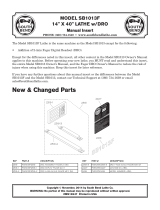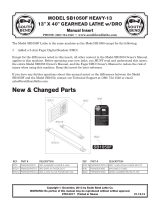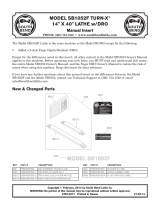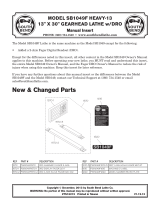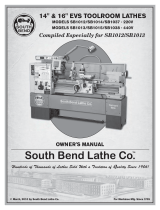
2
1.0 IMPORTANT SAFETY
INSTRUCTIONS
Read and understand the entire owner's
manual before attempting set-up or operation
of this lathe.
WARNING: To reduce risk of injury:
1. This machine is designed and intended for use
by properly trained and experienced personnel
only. If you are not familiar with the proper and
safe use of lathes, do not use this machine
until proper training and knowledge have been
obtained.
2. Keep guards in place. Safety guards must be
kept in place and in working order.
3. Remove adjusting keys and wrenches. Before
turning on machine, check to see that any
adjusting wrenches are removed from the tool.
4. Reduce the risk of unintentional starting. Make
sure switch is in the OFF position before
plugging in the tool.
5. Do not force tools. Always use a tool at the
rate for which it was designed.
6. Use the right tool. Do not force a tool or
attachment to do a job for which it was not
designed.
7. Maintain tools with care. Keep tools sharp and
clean for best and safest performance. Follow
instructions for lubrication and changing
accessories.
8. Always disconnect the tool from the power
source before adjusting or servicing.
9. Check for damaged parts. Check for alignment
of moving parts, breakage of parts, mounting,
and any other condition that may affect the
tool’s operation. A guard or any part that is
damaged should be repaired or replaced.
10. Keep work area clean. Cluttered areas and
benches invite accidents.
11. Keep work area well lighted.
12. Keep children and visitors away. All visitors
should be kept a safe distance from the work
area.
13. Make the workshop child proof. Use padlocks,
master switches, and remove starter keys.
14. Wear proper apparel. Loose clothing, gloves,
neckties, rings, bracelets, or other jewelry may
get caught in moving parts. Non-slip footwear
is recommended. Wear protective hair
covering to contain long hair. Do not wear any
type of glove.
15. Always wear ANSI Z87.1 approved safety
glasses or face shield while using this
machine. (Everyday eyeglasses only have
impact resistant lenses; they are not safety
glasses.)
16. Do not overreach. Keep proper footing and
balance at all times.
17. Do not place hands near the chuck or
workpiece while the machine is operating.
18. Do not perform any set-up work while machine
is operating.
19. Read and understand all warnings posted on
the machine.
20. This manual is intended to familiarize you with
the technical aspects of this lathe. It is not, nor
was it intended to be, a training manual.
21. CALIFORNIA PROPOSITION 65 WARNING:
This product contains chemicals known to the
State of California to cause cancer, or birth
defects or other reproductive harm.
22. This product, when used for welding, cutting, or
working with metal, produces fumes, gases, or
dusts which contain chemicals known to the
State of California to cause birth defects and, in
some cases, cancer. (California Health and
Safety Code Section 25249.5 et seq.)
23. Do not attempt to adjust or remove tools during
operation.
24. Never stop a rotating chuck or workpiece with
your hands.
25. Choose a low spindle speed when working
unbalanced workpieces, and for threading and
tapping operations.
26. Do not exceed the maximum speed of the
workholding device.
27. Do not exceed the clamping capacity of the
chuck.
28. Workpieces longer than 3 times the chucking
diameter must be supported by the tailstock or a
steady rest.
29. Avoid small chuck diameters with large turning
diameters.
30. Avoid short chucking lengths and small chucking
contact.
31. Turn off the machine and disconnect from power
before cleaning. Use a brush to remove shavings
or debris — do not use bare hands.
32. Do not stand on the machine. Serious injury
could occur if the machine tips over.




















